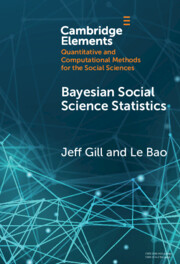References
Bartels, L. M. (1996). Pooling disparate observations. American Journal of Political Science, 40(3), 905–942.
Bayes, T. (1763). Lii. An essay towards solving a problem in the doctrine of chances. By the late Rev. Mr. Bayes, frs communicated by Mr. Price, in a letter to John Canton, amfr s. Philosophical Transactions of the Royal Society of London, (53), 370–418.
Berk, R. A., Western, B., & Weiss, R. E. (1995). Statistical inference for apparent populations. Sociological Methodology, 421–458.
Birnbaum, A. (1962). On the foundations of statistical inference. Journal of the American Statistical Association, 57(298), 269–306.
Canes-Wrone, B., Brady, D. W., & Cogan, J. F. (2002). Out of step, out of office: Electoral accountability and house members’ voting. American Political Science Review, 96(1), 127–140.
Christensen, W. F., & Florence, L.W. (2008). Predicting presidential and other multistage election outcomes using state-level pre-election polls. The American Statistician, 62(1), 1–10.
Copas, J. (1969). Compound decisions and empirical bayes. Journal of the Royal Statistical Society: Series B (Methodological), 31(3), 397–417.
Dale, A. I. (2012). A history of inverse probability: From Thomas Bayes to Karl Pearson. Springer Science & Business Media.
Diaconis, P., & Freedman, D. (1986). On the consistency of bayes estimates. The Annals of Statistics, 14(1), 1–26.
Fisher, R. A. (1922). On the mathematical foundations of theoretical statistics. Philosophical Transactions of the Royal Society of London. Series A, Containing Papers of a Mathematical or Physical Character, 222(594–604), 309–368.
Fisher, R. A. (1925). Theory of Statistical Estimation. Mathematical Proceedings of the Cambridge Philosophical Society, 22(5), 700–725.
Founta, A.-M., Djouvas, C., Chatzakou, D. et al. (2018). Large scale crowdsourcing and characterization of Twitter abusive behavior. In 11th international conference on web and social media, ICWSM 2018.
Gelman, A., Carlin, J. B., Stern, H. S., Dunson, D. B., Vehtari, A., & Rubin, D. B. (2015). Bayesian data analysis (3rd ed.). CRC Press.
Gelman, A., Hullman, J., Wlezien, C., & Morris, G. E. (2020). Information, incentives, and goals in election forecasts. Judgment and Decision Making, 15(5), 863–880.
Gill, J. (1999). The insignificance of null hypothesis significance testing. Political Research Quarterly, 52(3), 647–674.
Gill, J. (2014). Bayesian methods: A social and behavioral sciences approach (Vol. 20). CRC Press.
Gill, J., & Freeman, J. R. (2013). Dynamic elicited priors for updating covert networks. Network Science, 1(1), 68–94.
Gill, J., & Torres, M. (2019). Generalized linear models: A unified approach (Vol. 134). Sage.
Gill, J., & Walker, L. D. (2005). Elicited priors for Bayesian model specifications in political science research. The Journal of Politics, 67(3), 841–872.
Groves, R. M., & Lyberg, L. (2010). Total survey error: Past, present, and future. Public Opinion Quarterly, 74(5), 849–879.
Isakov, M., & Kuriwaki, S. (2020). Towards principled unskewing: Viewing 2020 election polls through a corrective lens from 2016. Harvard Data Science Review, 2(4).
Kolmogorov, A. N. (1933). Grundbegriffe der wahrscheinlichkeitreichnung. Ergebnisse der Mathematik.
Lauderdale, B. E., Bailey, D., Blumenau, J., & Rivers, D. (2020). Model-based pre-election polling for national and sub-national outcomes in the US and UK. International Journal of Forecasting, 36(2), 399–413.
Leamer, E. E. (1972). A class of informative priors and distributed lag analysis. Econometrica: Journal of the Econometric Society, 40(6), 1059–1081.
Madson, G. J., & Hillygus, D. S. (2020). All the best polls agree with me: Bias in evaluations of political polling. Political Behavior, 42(4), 1055–1072.
Stein, R. M., Mann, C., Stewart III, C. et al. (2020). Waiting to vote in the 2016 presidential election: Evidence fromamulti-county study. Political Research Quarterly, 73(2), 439–453.
Stigler, S.M. (1982). Thomas Bayes’s Bayesian inference. Journal of the Royal Statistical Society: Series A (General), 145(2), 250–258.
Stigler, S. M. (1983). Who discovered Bayes’s theorem? The American Statistician, 37(4a), 290–296.
Stoetzer, L. F., Leemann, L., & Traunmueller, R. (2024). Learning from polls during electoral campaigns. Political Behavior, 46(1), 543–564.
Stunt, J., van Grootel, L., Bouter, L., Trafimow, D., Hoekstra, T., & de Boer, M. (2021). Why we habitually engage in null-hypothesis significance testing: A qualitative study. Plos One, 16(10), e0258330.
Wagner, K., & Gill, J. (2005). Bayesian inference in public administration research: Substantive differences from somewhat different assumptions. International Journal of Public Administration, 28(1–2), 5–35.
Zellner, A. (1996). An introduction to Bayesian inference in econometrics. Wiley.


